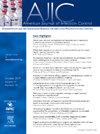Evaluation of the adherence to surgical antibiotic prophylaxis recommendations and associated factors in a University Hospital: A cross-sectional study
IF 3.8
3区 医学
Q2 INFECTIOUS DISEASES
引用次数: 0
Abstract
Background
Surgical antibiotic prophylaxis (SAP) is an important preventive measure, aiming to minimize surgical site infections. However, despite evidence-based guidelines, adherence to SAP protocols remains suboptimal in clinical practice. The aim of this study was to assess the adequacy of SAP in a high-complexity hospital and investigate associated factors.
Methods
A cross-sectional design was conducted, involving surgeries performed by expert teams in cardiology, urology, neurology, and gastrointestinal. SAP prescriptions were evaluated based on indication, antibiotic choice, dosage, and duration, according to the hospital protocol. Data analysis included descriptive statistics and association tests between protocol adherence and patient demographics, clinical variables, surgical teams, and types of surgeries.
Results
Out of 1,864 surgeries, only 20.7% adhered to SAP protocols. Lower adherence rates were observed for antibiotic choice and duration of prophylaxis. Neurological surgeries exhibited significantly lower adherence, particularly concerning antibiotic choice and duration. Factors associated with nonadherence included elevated preoperative blood glucose levels, prolonged hospitalization, and extended surgical duration. Logistic regression analysis identified surgical teams as significant factors influencing protocol adherence.
Conclusions
Despite the relatively high adherence to antibiotic dosage, challenges persist in antibiotic choice and duration adjustment. Poor glycemic control, prolonged surgery, and surgical teams were variables associated with inappropriate practice.
评估一家大学医院对手术抗生素预防建议的遵守情况及相关因素:一项横断面研究。
背景:手术抗生素预防(SAP)是一项重要的预防措施,旨在最大限度地减少手术部位感染。然而,尽管有循证指南的指导,临床实践中对 SAP 方案的遵守情况仍然不尽如人意。本研究旨在评估一家高复杂性医院的 SAP 是否充分,并调查相关因素:研究采用横断面设计,涉及心脏科、泌尿科、神经科和胃肠科专家团队实施的手术。根据医院规程,根据适应症、抗生素选择、剂量和持续时间对 SAP 处方进行评估。数据分析包括描述性统计和方案遵守情况与患者人口统计学、临床变量、手术团队和手术类型之间的关联测试:在1864例手术中,只有20.7%的手术遵守了SAP方案。抗生素选择和预防时间的遵守率较低。神经外科手术的依从性明显较低,尤其是在抗生素选择和持续时间方面。与不依从性相关的因素包括术前血糖水平升高、住院时间延长和手术时间延长。逻辑回归分析发现,手术团队是影响方案依从性的重要因素:结论:尽管抗生素剂量的依从性相对较高,但在抗生素选择和疗程调整方面仍存在挑战。血糖控制不佳、手术时间过长和手术团队是与不当操作相关的变量。
本文章由计算机程序翻译,如有差异,请以英文原文为准。
求助全文
约1分钟内获得全文
求助全文
来源期刊
CiteScore
7.40
自引率
4.10%
发文量
479
审稿时长
24 days
期刊介绍:
AJIC covers key topics and issues in infection control and epidemiology. Infection control professionals, including physicians, nurses, and epidemiologists, rely on AJIC for peer-reviewed articles covering clinical topics as well as original research. As the official publication of the Association for Professionals in Infection Control and Epidemiology (APIC)

 求助内容:
求助内容: 应助结果提醒方式:
应助结果提醒方式:


